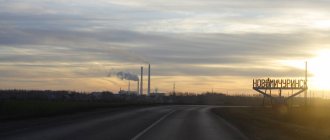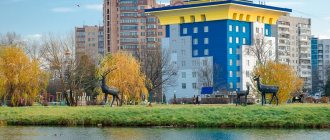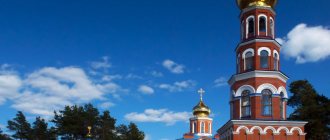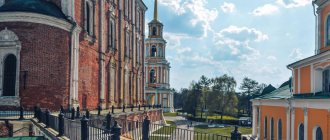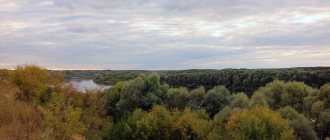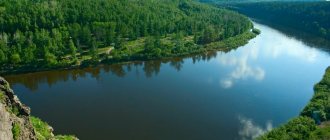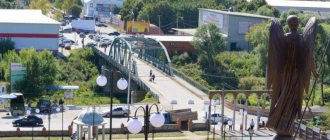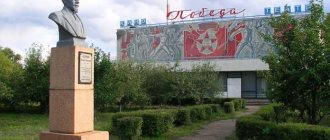In this article I will tell you about the Ryazan region, how it can attract travelers, about interesting places and festive events that periodically take place in various settlements of the Ryazan region. For me, the Ryazan region is associated with the most beautiful endless fields, the bend of the Oka, steep banks with water meadows. Ryazan nature personifies the typical landscape of central Russia. But that’s what makes her so sweet to me. The guide will tell you about the most interesting sights of the Ryazan region, including beautiful churches, estates and simply beautiful natural places.
There are truly remote places here that can unexpectedly surprise you with some amazing architectural masterpiece. The Ryazan region is a small homeland for dozens of outstanding people, such as the poet S.A. Yesenin, scientist K.E. Tsiolkovsky, author of the music of our country's anthem A.V. Alexandrov, opera singers the Pirogov brothers, creator of the Sochi arboretum S.N. Khudekov, breeder I.V. Michurin and many others. Almost all the villages where these famous people were born now have museums dedicated to them.
Geographical position
The Ryazan region is located in the central part of the Russian (East European) Plain and borders the Republic of Mordovia, Penza, Tambov, Lipetsk, Tula, Moscow, Vladimir and Nizhny Novgorod regions. The geographical center of the Ryazan region is located in the village of Lunino, Shilovsky district. The Ryazan province lies between 53 and 55 degrees North latitude and between 55 and 59 degrees longitude.
The area of the region is 39.6 thousand square meters. km.
- the northern point is on the shore of the lake. Holy on the border with the Vladimir region;
- southern - near the village of Katino, Aleksandro-Nevsky district (on the border with the Tambov region);
- western - on the border with the Tula and Moscow regions,
- eastern - near the village. Umet on the border with the Republic of Mordovia.
The best cities and resorts in the Ryazan region
The capital of the Ryazan region - the city of Ryazan - is a modern cultural and economic center of the region, where life is truly in full swing and there is hardly a place for boredom. The pearl of Ryazan is called its Kremlin, the construction of which lasted from the 15th to the 19th centuries and gave the city its unique appearance with elements of classicism and architectural monuments made in the traditional Old Russian style.
Among the attractions of the Ryazan region, Orthodox complexes in the form of the Ryazan Assumption Cathedral and the Nativity of Christ Church, the St. John the Theologian Monastery of the Holy Dormition Vyshensky Convent, have firmly established themselves.
Authors: Alexander Gordiets (editor-in-chief)
Relief
The maximum length of the region from north to south is about 225 km, from west to east – up to 250 km, the total length of the borders is about 800 km.
The Ryazan region, like Moscow, is located in time zone II.
The largest surface irregularities of the Russian Plain in the Ryazan region are the northeastern part of the Central Russian Upland, the northern part of the Oka-Don Plain and the southern part of the Meshchera Lowland. The maximum surface elevation within the region - 245 m - is located in the Central Russian Upland, the minimum - 78 m - in the valley of the Oka River at its outlet to the Vladimir region (Kasimovsky district).
Climate
The climate of the region, located in the temperate continental zone, is temperate continental with warm summers and moderately cold winters. The amount of total solar radiation arriving at the surface of the earth within the region increases from north to south from 90 to 95 kcal/cm2 year.
Winter. The average temperature of the coldest month - January - decreases from west to east from -10.50C in the Mikhailov area to -120C on the border with the Republic of Mordovia. January isotherms, as on the Russian Plain as a whole, are elongated in the meridional direction. This is due to the fact that in winter heat is carried to the Russian Plain from the Atlantic. In the southwestern, most elevated part of the region, average January temperatures are relatively low, up to -110C – -11.20C. The effect of lowering temperature is related to altitude.
Summer. The average temperature of the warmest month – July – increases from northwest to southeast from +18.50C to +19.50C. The lowest values of average July temperatures, as in January, are observed in the relatively elevated southwestern part of the region, which is associated with a decrease in temperature with height. The average annual air temperature is positive. In the northern regions of the region it is slightly below +40C, in the southern – more than +40C. The duration of the frost-free period on average ranges from 134 days in the northern part of the region to 150 days in the southern part.
The annual amount of precipitation in the region ranges from 700 mm in the northern part to 600 mm or less in the southwest of the region. The northern part of the region, located on the left bank of the Oka and the right bank of the Moksha, is characterized by excess moisture (precipitation exceeding evaporation). To the south of Ryazan, moisture becomes insufficient.
The distribution of precipitation throughout the region is uneven throughout the year. During the warm period, 70% of the annual precipitation falls in most of the region; in the south this figure can be even higher. Most precipitation occurs in July, the minimum amount occurs in March-April. Thunderstorms are frequent at the beginning and until mid-summer, but August is usually dry and hot. The number of days with snow cover ranges from 136 in the south to 140-145 in the north and northeast. The snow thickness in the north reaches 35-50 cm, in the south it is almost two times lower - 27-31 cm. Snowstorms are frequent from December to February. The Ryazan region is characterized by the most dangerous natural phenomena: spring floods, peat fires and strong winds.
Links[edit]
| Wikimedia Commons has media related to Ryazan Oblast . |
Notes[edit]
- President of Russian Federation. Decree No. 849 of May 13, 2000 “On the Plenipotentiary Representative of the President of the Russian Federation in the Federal District.” Entered into force on May 13, 2000. Published: “Collection of Legislation of the Russian Federation”, No. 20, Art. 2112, May 15, 2000 (Decree of the President of the Russian Federation of May 13, 2000 No. 849 “ On the Plenipotentiary Representative of the President of the Russian Federation in the Federal District
.” Entered into force on May 13, 2000). - Gosstandart of the Russian Federation. No. OK 024-95 December 27, 1995 “All-Russian classifier of economic regions. 2. Economic regions,” ed. Changes No. 5 / 2001 OKER. (Gosstandart of the Russian Federation. No. OK 024-95 dated December 27, 1995. Russian classification of economic regions. 2. Economic regions
as amended by Amendment No. 5/2001 OKER.). - Article 7 of the Charter of the Ryazan Region states that the region may have an anthem if the corresponding law is adopted. As of 2015, there is no such law. The “Symbols” section of the official website of the Ryazan region also lacks an anthem.
- ↑
Decree of September 26, 1937 - ^ a b Charter of the Ryazan region, article 27.
- Official website of the Ryazan region. Lyubimov Nikolay Viktorovich (in Russian)
- Federal State Statistics Service (Federal State Statistics Service) (May 21, 2004). "Territory, number, settlements and administrations by subject of the Russian Federation (territory, number of districts, settlements and rural administration by subject of the Russian Federation)". All-Russian Population Census of 2002 (All-Russian Population Census of 2002
). Federal State Statistics Service. Retrieved November 1, 2011. - "On the Calculation of Time". Official Internet portal of legal information
. June 3, 2011. Retrieved January 19, 2022. - ↑
An official throughout the Russian Federation in accordance with Article 68.1 of the Russian Constitution. - ^ abc Federal State Statistics Service (2011). “All-Russian Population Census 2010. Volume 1" [All-Russian Population Census 2010, vol. 1]. All-Russian Population Census 2010 [All-Russian Population Census 2010]
. Federal State Statistics Service. - ↑
Federal State Statistics Service of Russia (May 21, 2004).
“The population of Russia, the constituent entities of the Russian Federation as part of federal districts, urban settlements, settlements, settlements is 3 thousand or more people” [Population of Russia, its federal districts, federal constituent entities, districts, urban settlements, rural settlements - administrative centers and rural settlements with a population of more than 3,000 people] (XLS). All-Russian Population Census of 2002 [All-Russian Population Census of 2002]
. - “All-Union Population Census of 1989. The current population of union and autonomous republics, autonomous regions and districts, territories, effects, urban settlements and rural district centers” [All-Union Population Census of 1989: current population of union and autonomous republics, Autonomous regions and districts, territories, regions, districts, urban settlements, villages performing the functions of district administrative centers. All-Union Population Census of 1989 [All-Union Population Census of 1989]
.
Institute of Demography of the National Research University: Higher School of Economics [Institute of Demography of the National Research University: Higher School of Economics]. 1989 - via Demoscope Weekly
. - https://www.gks.ru/free_doc/2012/demo/edn12-12.htm
- https://www.gks.ru/wps/wcm/connect/rosstat_main/rosstat/ru/statistics/publications/catalog/doc_1137674209312
- https://www.perepis-2010.ru/news/detail.php?ID=6936
- ^ abc "Arena: Atlas of religions and nationalities of Russia". Wednesday, 2012.
- 2012 Arena Atlas Religion Maps. “Ogonyok”, No. 34 (5243), 08/27/2012. Retrieved 04/21/2017. Archived.
Water resources
Rivers. The rivers of the region belong to the basins of the Caspian and Azov seas. Most of the Ryazan region is drained by the river. The Okoya and its tributaries belong to the Caspian Sea basin, the smaller one is located in the south and southwest, drained by the river. The Don and its tributaries belong to the Azov Sea basin. In total, there are 895 rivers in the region with a length of more than 2 km, including 257 with a length of more than 10 km and a total length of 6652 km.
The Don River runs along the border of the region in two sections. In the south of the region, the Don basin includes the rivers Polny Voronezh, Lesnoy Voronezh and Stanovaya Ryasa. In the southwest of the region, about 15 small rivers flow directly into the Don - Kochurovka, Rozhnya, Kruglianka, Panika, etc.
The main water artery of the region is the Oka River, the largest and most abundant right tributary of the Volga. The river originates in the south of the Oryol region. Its length is 1,478 km, of which 489 km are within the Ryazan region. River basin Oka belongs to 850 rivers and streams with a total length of 9886 km, including 14 rivers with a length of more than 10 km. The largest right tributaries of the Oka within the region are the rivers Moksha, Pronya, Para, Istya, Vozha; left - Unzha, Gus, Pra. The rivers have mixed feeding with a predominance of snow. The rivers freeze at the end of November - beginning of December, and open at the end of the first - beginning of the second ten days of April. The water level in the Oka rises by 5-6 m, in some years by 9-11 m. At the same time, the water floods the floodplain.
Lakes. There are 2838 lakes in the region with an area of more than 0.2 hectares. Their total area is 245.8 square meters. km. Of these, 1,400 lakes have an area of more than 1 hectare, 1,438 are less than 1 hectare. 12 lakes have an area of more than 1 sq. km. The largest of them is Lake Velikoye with a surface area of 20.7 square meters. km. The deepest is Beloe near the village of Beloe, Klepikovsky district (according to various sources, depth is from 45 to 56 m).
Swamps. Within the region there are about 1230 swamps with a total area of about 92.5 thousand hectares. The overwhelming majority of the swamps are concentrated in Meshchera.
Ryazan
History of the city of Ryazan
Based on the results of archaeological excavations, it was established that the first settlements on the site of the ancient city appeared in the Mesolithic era. The Slavs developed these lands in the 6th-7th centuries. It is known that local residents actively traded with Byzantium, as well as with peoples living in the East and Western European countries.
General plan of Ryazan 1909
To protect the expanding settlements and guard the commercial port, a fortified city was needed, so in the 11th century, the first fortress appeared among the dense forests - Pereyaslavl-Ryazan. The houses of the new city stood close together, and its streets were covered with wooden pavements. From the lakes located on the hill, the inhabitants took water during the siege; they hunted in the surrounding forests, and fished on the Oka and its tributaries. Gradually, Pereyaslavl-Ryazansky became one of the most fortified outposts on the watershed of the Oka and Volga.
In those days, the main city of the principality was Ryazan, located 65 km from Pereyaslavl-Ryazan. In the winter of 1237, Mongol troops raided Rus' and destroyed the princely capital. They burned the ancient city to the ground, so they did not rebuild it. First, the bishop's chair was moved to Pereyaslavl-Ryazan, and from the middle of the 14th century it became the capital of the Ryazan principality.
Panorama of the Kremlin Hill from the embankment of the Trubezh River
During the Patriotic War of 1812, people from territories occupied by the French were evacuated to Ryazan. Local residents willingly joined the people's militia, and the Ryazan province received about 32 thousand wounded.
During the Great Patriotic War, Ryazan was subjected to massive raids by fascist aircraft. More than 300 bombs were dropped on the city, and many buildings were damaged by the bombing. The advance of German troops was stopped just 30 km from Ryazan, near the village of Zakharovo.
In the post-war years, the city turned into a large industrial and cultural center. Several giant factories, large research centers and universities were built here. In addition, Ryazan became the main training center for the country's Airborne Forces.
Monument to Lenin in Ryazan
Pochtovaya street
Ryazan Kremlin
In the 11th century, the fortifications of Pereyaslavl-Ryazan occupied about 2 hectares and were located on the most elevated part of the right bank of the Oka. When the spring flood came and the Oka, Trubezh and Lybid rivers overflowed, the Kremlin hill turned into an impregnable island.
For a long time the Kremlin in Ryazan was made of wood. Stone construction began here only in the 16th century. Since 1918, the Kremlin territory received the status of a museum, and the ancient buildings were restored. During the Great Patriotic War, air defense units were stationed in the Ryazan Kremlin. The architectural complex was lucky - it was practically not damaged by the bombing.
Ryazan Kremlin
Monument to Evpatiy Kolovrat in Ryazan
In the post-war years, restoration continued. The main difficulties were caused by strengthening the foundations of the ancient Assumption Cathedral and the Cathedral Bell Tower. To carry out complex engineering work, it was necessary to invite metro construction specialists from Moscow.
Chapel in honor of the 900th anniversary of Ryazan
Nowadays, the Ryazan Kremlin plays the role of the architectural dominant of the old part of the city. The Assumption Cathedral and the Cathedral Bell Tower rise high and can be seen from afar - not only from Ryazan itself, but even from the surrounding villages. The Kremlin hill is surrounded by the valleys of the Lybid and Trubezh rivers, and on one side it is limited by a man-made ditch.
Previously, four gates led to the territory of the Ryazan Kremlin, and there were 12 towers on its walls. Today, along the perimeter of the ancient fortifications, only old earthen ramparts have been preserved. There are several Orthodox churches in the Kremlin. Some of them are freestanding, while others are located inside civil buildings.
The central part of the historical and architectural complex is occupied by the five-domed Assumption Cathedral, which today serves as the cathedral church of the Ryazan Metropolis. The walls of the ancient cathedral are decorated with lace white stone carvings, and inside it there is the tallest iconostasis in Russia.
The oldest building in the Kremlin is the Nativity of Christ Cathedral, built at the beginning of the 15th century. This temple was reconstructed many times, and it acquired its modern appearance by the end of the 19th century. In the Nativity of Christ Cathedral you can see the tombs of the princes and princesses who ruled in Ryazan. Monuments of the 17th century on the territory of the Ryazan Kremlin are the Transfiguration Cathedral, the Church of the Holy Spirit, the Church of the Epiphany, the Elijah Cathedral, the Church of the Savior on the Yar and the Archbishop's House Church.
Cathedral of the Nativity of Christ in Ryazan
Church of the Savior on Yar
Today, the Kremlin has six permanent exhibitions. Many exhibitions, animation programs, holidays and festivals take place here. Oleg's palace, the singing and consistory buildings, the Cherni hotel (XVII century), as well as the site of archaeological excavations are available for tourists. In addition, on the territory of the Ryazan Kremlin you can take a memorable photo in folk costume.
The museum complex is open to visitors on all days except Mondays, from 10.00 to 18.00. The ticket office closes 45 minutes earlier.
Museums of Ryazan
Ryazan is a city with a long history, so there are many interesting museums here. The main museum center is the territory of the Ryazan Kremlin. The art museum, which bears the name of the famous Russian engraver Ivan Petrovich Pozhalostin, is very popular among tourists. The museum collections are housed in an ancient building built at the turn of the 18th-19th centuries (57 Svobody Street). Its halls display rich collections of paintings, graphics, sculptures and applied works made by domestic and Western European artists. The museum is open every day except Monday, from 11.00 to 19.00.
Walls and towers of the Spassky Monastery of the Ryazan Kremlin
In the very center of Ryazan there is a small cozy mansion surrounded by an orchard. The estate of academician Ivan Petrovich Pavlov is located on the street named after the famous physiologist (Pavlova St., 25). The furnishings of Pavlov’s house, the scientist’s personal belongings, his books and manuscripts are exactly preserved here. The estate museum welcomes guests from Tuesday to Friday from 9.00 to 18.00, and on Saturday and Sunday from 10.00 to 18.00.
There is a museum of travelers in the city, which tells about the expeditions and sports trips of the residents of Ryazan (Lenin St., 35). The hallmark of this museum was the exhibition “Russian America: From Ryazan to Yukon.” The Travelers Museum is open from Monday to Thursday from 9.00 to 18.00, and on Friday from 9.00 to 17.00. It is closed on Saturdays and Sundays.
View of the Cathedral Bell Tower from Glebovsky Bridge
Three museums dedicated to military topics have been created in the regional center. On Margelov Square, 1, a museum of the history of the Airborne Forces is opened, at the air base in Dyagilevo there is a museum of long-range aviation (Belyakova St.), and on Military Motorists Street, 12, a museum of military automotive equipment welcomes guests.
Not long ago, a gingerbread gallery was created in Ryazan and gingerbread and gingerbread products of various shapes and sizes were exhibited in it. In the new museum you can see miniature gingerbread houses, a gingerbread village covered in snow-white glaze, and gingerbread cookies in the form of animal and flower figures. Here you not only look at delicious culinary masterpieces, but also taste them. The gingerbread gallery is located on the street. Svobody, 4, and is open daily from 10.00 to 19.00.
What to see in the vicinity of Ryazan
From the regional center, excursions to one of the largest ancient Russian cities of the 12th-13th centuries - Old Ryazan - are popular. The former capital of the Ryazan principality today has the status of an archaeological reserve and historical landscape monument. There are no buildings or streets left on its territory. The settlement occupies 60 hectares of a mown field, and around it rise earthen ramparts covered with grass. Below, by the river there is a small village of Staraya Ryazan, where there is an old church.
Old Ryazan
Despite large-scale work, to date archaeologists have explored only 10% of the site. The artifacts they found are exhibited in museums in Ryazan. In addition, a large collection of objects from Old Ryazan is exhibited in the museum of the town of Spas-Ryazan, which is located 3 km from the excavation site (Sovetskaya St., 18). The museum is open to guests every day except Monday, from 9.00 to 18.00.
Church of the Assumption of the Virgin Mary in Glebovo-Gorodishche
From Ryazan it is easy to go to Glebovo-Gorodishche - the place where the famous battle on the Vozha River took place, in which the troops of Dmitry Donskoy and Khan Begich took part (1378). The remains of the Slavic settlement are located in a picturesque area and measure 112 m by 85 m. Traces of archaeological excavations are visible on the field, and the Church of the Assumption of the Virgin Mary rises.
Every year in August a lot of people come to Glebovo-Gorodishche. During the military-historical festival, fencing tournaments, archery and wrestling competitions, as well as a re-enactment of the battle on the river are held here. Vozhe. Master classes on sword techniques, archery and the basics of blacksmithing are held for guests.
Not far from Ryazan, in the village of Konstantinovo, on the high right bank of the Oka, there is a museum-reserve of S. A. Yesenin. This place has long become a cult place for domestic and foreign tourists. People travel to the homeland of the famous Russian poet by car, bus and cruise ship.
Yesenin Museum in the village of Konstantinovo
In the village, the house where Yesenin grew up, the old Church of the Kazan Icon of the Mother of God, the house of the local priest Father John and the building of the Zemstvo Primary School have been preserved. Tourists can visit the poet’s literary museum and a museum exhibition dedicated to Yesenin’s poem “Anna Snegina”. The Museum of “One Poem” occupies a house with a mezzanine, which was owned by local landowner L. I. Kashina.
Transport
Bus in Ryazan
It is convenient to travel around Ryazan by buses, trolleybuses and minibuses. Passengers pay for travel on them in cash and using electronic tickets. In the warm season, river trams run from the Kremlin pier, serving river excursion routes. In addition, tourists who come to Ryazan can always use a taxi or rent bicycles.
The fare in the city is fixed, and tariff zones have been established on Solotchinsky and suburban routes. When planning a trip around Ryazan by public transport, you should keep in mind that this is a large city, and the problem of traffic jams is quite acute.
Ryazan from a bird's eye view
Souvenirs
The Ryazan land is famous for its original crafts, so travelers are happy to purchase products from local craftsmen as souvenirs. In the regional center you can buy beautiful Skopino ceramics. These are dishes and toys made in the small town of Skopin, which is located 100 km from Ryazan. Skopino ceramics are distinguished by complex modeling and expressive forms. Potters from Skopin know how to make shaped vessels and glazed crafts in the form of fairy-tale lions, dragons, fish, centaurs and the Osprey bird.
Souvenirs from Ryazan
In the ancient Ryazan city of Mikhailov, lace making is developed. Local craftswomen know the secrets of making complex colored lace and use original geometric patterns with ancient symbols of the sun and water. The works of Mikhailovsky lacemakers can be bought in Ryazan, however, they are not cheap.
The regional center also sells products made by embroiderers from the city of Kadom - the famous “Kadom veniz”. This craft developed thanks to Peter I. The Russian Emperor ordered embroiderers from Venice to be brought to the Kadoma Monastery, and they taught local nuns fine needlework. Today, souvenir shops in Ryazan sell Kadom tablecloths, towels, napkins, collars and other souvenirs.
In the Shilovsky district of the Ryazan region, people have long been proficient in the technique of wicker weaving. Crafts made from wicker are very popular among tourists, as they are very beautiful and practical. Wicker furniture and kitchen utensils are sold in almost all souvenir shops in the regional center.
Souvenirs related to Sergei Yesenin are in great demand among travelers coming to Ryazan. The Ryazan region is the poet’s homeland, so collections of his poems, portraits of Yesenin and photo albums of natural attractions are brought from here.
Information for travelers
There are offices of the Tourist Information Center in Ryazan, by visiting which you can solve any question that guests of the city may have - where to stay, which museum is better to go to and how the most popular restaurants work. Specialists of the Tourist Information Center can tell you about the protected areas of the Ryazan region, natural and historical monuments, parks, excursion routes and the work of public transport. Here you can book excursions, receive free maps of Ryazan and the Ryazan region, as well as booklets about local attractions.
The offices of the Tourist Information Center are located on the street. Nikolodvoryanskaya, 22 (room 18) and st. Griboyedova, 26/6 (office 10). They are open from Monday to Friday from 9.00 to 18.00.
Hotel deals
Booking.com
How to get there
Ryazan is located 190 km southeast of Moscow. You can get to the city along Novoryazanskoye Highway in 2.5-3 hours.
Bus in Ryazan
Ryazan is also reached by rail. Electric trains and luxury express trains “Sergei Yesenin” run here from the capital. Three express trains depart daily from the capital's Kazansky station, and they reach Ryazan in 2 hours 45 minutes.
Long-distance trains pass through the city. Two Ryazan train stations are located in the city center. Trains run through Ryazan-1 (Vokzalnaya St., 26A) to Saransk, Penza, cities of Central Asia and the Southern Urals. And through Ryazan-2 (Dimitrova St., 1) trains run to Samara and the southern regions of Russia.
Many Ryazan residents and city guests come to Ryazan by regular buses. Comfortable buses depart every half hour from the Moscow metro station “Kotelniki” and from the Kazansky railway station. They get to Ryazan in 3 hours.
Since the Oka River flows through the city, it is easy to get here by river transport. The popular tourist cruise routes “Moscow Around the World”, “Moscow – Konstantinovo” and “Moscow – Kasimov – Ryazan” are laid through Ryazan.
Vegetable world
At the beginning of 2016, the forested area was 950.1 thousand hectares. The forest cover of the region was 24.0%. The main part of the forests is located in the northeastern part of the region and is included in the zone of coniferous-deciduous forests. In the southwestern half of the region, forests are located in the forest-steppe and steppe zones.
Broad-leaved forests include such tree species as ash, sycamore and Norway maples, linden, and oak. The undergrowth consists of bird cherry, rowan, buckthorn, euonymus and forest honeysuckle. In the grass cover you can find the types of grasses common to the central zone: perennial forest grass, bluebell, violet, wild strawberry, yellow greenberry, oak manna, male shield, etc. In coniferous forests, spruce and pine trees predominate; various types of shrubs are found - blueberries, lingonberries, cranberries , blue lightning.
A significant part of the forest cover is birch and oak forests. Of the meadow and field plants, the most common are meadow clover, alfalfa, fescue, timothy, meadow geranium, bluebell, brome, etc. In the southwest of the region, vegetation characteristic of the steppe zone is widely represented: feather grass, thyme, wheatgrass, yarrow, wormwood. In total, about 1,300 plant species are currently registered in the Ryazan region, of which over 100 are listed in the region’s Red Book.
Economics [edit]
Solotchinsk peat railway
The Ryazan region is part of the Central Economic Region. The region is in an economically advantageous geographical position thanks to water and land routes passing through it, ensuring stable internal and external economic relations. It is considered both an industrial and agricultural region. The basics of agriculture in the region are animal husbandry and crop production. Livestock farming specializes in the raising and fattening of cattle, as well as the raising of pigs, sheep and poultry. Beekeeping is also well developed in the region.
Transport[edit]
- The Solotchinsky peat narrow-gauge railway is located in the Ryazan region.
- The Meshcherskoe peat narrow-gauge railway is located in the Klepikovsky district.
Animal world
The territory of the Ryazan region is inhabited by 67 species of mammals, 279 species of birds, 6 reptiles, 10 species of amphibians, 25 species of cyclostome fish and several tens of thousands of invertebrates.
The Ryazan region is inhabited by: elk, wild boar, wolf, fox, brown hare, beaver, squirrel, ferret; of rodents - gophers, hamsters, jerboas; Birds include teal, mallard, gray duck, etc. These include geese, swans, wood grouse and black grouse, owls, woodcocks, quail, partridges, etc. 80 species of fish are registered in the reservoirs of the region. Commercial fish species of the river. Okies are pike, bream, asp, perch, pike perch, roach. The most common are crucian carp, carp, roach, silver bream, ide and rudd, catfish, tench, blue bream, sabrefish, etc.
At the moment, 281 species of animals are listed in the Red Book of the region.
Demographics[edit]
Population
: 1,154,114 people (2010 census);
[10] 1,227,910 (2002 census); [11] 1,345,924 people (1989 census). [12] 2012
- Births: 12,351 (10.8 per 1,000)
- Deaths: 18,723 (16.3 per 1000) [13]
- Total Fertility Rate: [14]
2009 – 1.42 | 2010 - 1.44 | 2011 - 1.45 | 2012 - 1.54 | 2013 - 1.55 | 2014 - 1.60 | 2015 - 1.64 | 2016 - 1.70 (e)
Ethnic composition (2010): [10]
- Russians - 95.1%
- Ukrainians - 0.8%
- Armenians - 0.5%
- Mordvins - 0.5%
- Tatars - 0.5%
- Azerbaijanis - 0.4%
- Uzbeks - 0.3%
- Other - 1.9%
- 74,419 people were registered in administrative databases and could not indicate their nationality. The proportion of ethnic groups in this group is estimated to be the same as in the stated group. [15]
Religion[edit]
| Religion in the Ryazan region as of 2012 (Atlas Sreda Arena) [16] [17] | ||||
| Russian Orthodoxy | 63% | |||
| Other Orthodox | 1% | |||
| Other Christians | 3,2% | |||
| Islam | 1% | |||
| Rodnoverstvo and other local religions | 0,6% | |||
| Spiritual but not religious | 15,3% | |||
| Atheism and godlessness | 8,9% | |||
| Other and undeclared | 7% | |||
According to a 2012 survey [16], 63% of the population of the Ryazan region adhere to the Russian Orthodox Church, 3% are unaffiliated general Christians, 1% are Orthodox believers who do not belong to a church or do not belong to non-Russian Orthodox churches, 1% are Muslims, and 1 % are adherents of the Rodnoveria movement (Slavic primordial faith). In addition, 15% of the population state that they are "spiritual but not religious", 9% are atheists, and 7% follow other religions or did not answer the question. [16]
